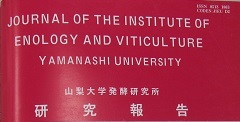

 |
山梨大学醗酵研究所 研究報告[1254年-1997年] JOURNAL OF THE INSTITUTE OF ENOLOGY AND VITICULTURE |
| vol.30 (1995) |
|
「ブドウ果汁沈殿中のインベルターゼの精製と性質」 Purification and Properties of an lnvertase from Grape Juice Precipitate 高柳 勉、奥田 徹、横塚弘毅(山梨大学工学部附属発酵化学研究施設) TSUTOMU TAKAYANAGI, TOHRU OKUDA, and KOKIYOKOTSUKA (lnstitute of Enology and Viticulture, Yamanashi University) pp. 1-8.[PDF] |
|
考 察 植物インベルターゼの発現や精製実験において同 -の植物組織中に2種類のインベルターゼが存在することが報告されている。すなわち、植物組織中に溶解している可溶性インベルターゼと高塩濃度の溶媒ではじめて抽出される不溶性インベルターゼである。この不溶性インベルターゼは細胞壁に結合したインベルターゼとして組織化学的染色法によりその細胞 レベルでの分布が明らかになっている。 同一組織中の可溶性および不溶性インベルターゼを比較した結果は植物の種類によりかなり異なっている。たとえば、小麦種子インベルターゼでは可溶性および不溶性インベルターゼの加水分解特性そのものが異なること、ダイコンの実生インベルターゼでは両インベルターゼタンパク質に結合した糖鎖の遠いにより、両インベルターゼの電荷の状態が異なることなかが報告されている。一方、Hawkerブドウ果実インベルターゼは細胞質や液胞に存在する可溶性インベルターゼがすべてで、不溶性インベルターゼは抽出の際にタンニンと複合体を形成してできる二次的産物であると報告している。 我々はブドウ果汁中に溶解している可溶性インベルターゼを精製する際に得られる果汁沈殿中(pH3.0では可溶化しない沈殿)にも強いインベルターゼ活性を見出した。 このインベルターゼ活性は0.2 Mホウ酸緩衝液 (pH8.5)によって可溶化され、果汁に溶解しているインベルターゼに較べて量的には圧倒的に多かった。果汁沈殿中のインベルターゼは 電気泳動による分析およびスクロース加水分解特性において果汁に溶解している可溶性インベルターゼと同一であることが示された。果汁沈殿の成分としてはタンパク質11.3%、中性糖17.9%、酸性糖40.2%、フェノール1.7%であり、タンパク質以外の成分が多く存在した。これ らの結果は、不溶性インベルターゼは果実を破砕した時に二次的に生ずる酵素タンパク質とタンニンの複合体であるという。 Hawkerの提案と一致している。しかし、組織化学的染色法によるマスカット・ベリーAブドウ果実成熟中の不溶性インベルターゼの検出実験では、不溶性インベルターゼが必ずしも二次的な産物ではないことが示されている。すわなち、成熟途中のブドウ果実のディスク状切片の活性染色実験は、ベレーゾン直後のブドウ果実組織に水洗処理では除けない強いインベルターゼ活性が存在することを示し、さらにその活性の上昇は可溶性インベルターゼ活性の上昇時期よりも早かった。 もし、活性染色により検出される不溶性インベルターゼが100%二次的産物であるならば、その活性の上昇時期は可溶性インベルターゼの上昇時期と一致するはずである。 したがって、ブドウ果実中の不溶性インベルターゼには、生体内で組織に結合しているものと果汁を取る際に可溶性インベルターゼが不溶化してできる二次的なものかあると考えるのが妥当であろう。しかし、ブドウ果実のインベルターゼが本質的1種類しか存在しないのかという疑問に対して答えを出すためには、成熟レベルの異なった果実から様々な抽出方法によりインベルターゼを抽出し、アイソザイムの有無を確認する必要がある。 An invertase was purified from a juice precipitate of Muscat Bailey A grapes by successive column chromatographies on DEAE Sepharose Fast Flow and Sephadex G-100. The pH and temperature optima of the enzyme were 3.5 and 80℃, respectively. The Km and V values of the enzyme for sucrose at pH4.0 were 4.3mM and 95.0μmoI GIc・mln-1・mg protein-1, respectively, The kinetic characteristics, electrophoretic mobility and molecular weight of the invertase from the Juice precipitate were the same as those or the invertase from the defecated juice. The two enzymes were therefore thought to be identical. |
|
「山梨県内ワイナリーの赤ワイン仕込みにおける乳酸菌の分布」 Identification of Lactic Acid Bacteria isolated during Red Wine Making at a Winery ln Yamanashi Prefecture 柳田藤寿、後藤亜紀人、芦沢 忠、内田多加夫、篠原 隆 (山梨大学工学部発酵化学研究施設、白百合醸造㈱ ) FUJTTOSHI YANAGIDA,AKTHITO GOTO,TADASHI ASHIZAWA, TAKAO UCHlDA, and TAKASHI SHINOHARA1 (lnstitute of Enology and Viticulture, Yamanashi University) pp. 9-17.[PDF] |
|
1992年度から1994年度の3年にわたり、白百合 醸造の赤ワイン製造 (MBA)工程中の果もろみから乳酸菌の分離を行い39株を分離した。それらの菌 株の同定を行ったところL.planLarum21、Lew. oenos6株、Leu.menesenteroides5株,L.yamanashiensis1株,L.brevis1l株, L.fermentum1株、Latobacillus.4株となった。分布を調べたところ、仕込み初期からは,L.plantarum8株が、仕込み後期からは、Lew.oenos4株が分離された。MLF1993年および1994年において野生乳酸菌により生起したが、1992年度では、生起しなかった。 Thirty-nine strains of lactic acid bacteria were isolated during the making of red wine from Muscat Bailey A grape sat Shirayurl Winery, Yamanashi Prefecture from 1992 to 1994. The strain isolated were classified as Lactobacillus tarum (25strains), Leuconostoc oenos(6 strains), Leuconostoc mesenteroides (5 strains), Lactobacillus yamanashiensis(1 straln), Lactobacillus brevis(1 strain), Lactobacillus fermentum(1 strain), Lactobacillus sp.(4 strains).Eight L plantarum strains were found in the first stage of the wine-making process, and four Leu.oenos strains in the later stage. In 1993 and 1994, malo-lactic fermentation occurred in the red wine as a result of wild-type lactic acid bacteria activity, but this did not take place in 1992. |
|
「山梨県産1991~1994年甲州種ヌーボーワインの化学分析値について」 General Analysis of Koshu-Nouveu Wines Produced in Yamanashi Prefecture between 1991 and 1994 山川 祥秀 (山梨大学工学部発酵化学研究施設) YOSHIHIDE YAMAKAWA (The Experimental Vineyard, Institute of Enology and Viticulture, Yamanashi University) pp. 19-26.[PDF] |
| Thirty-five bottles of Koshu-nouveau wine produced in 1991,34 bottles in 1992,32 bolltews in 1993 and 47 bottles in 1994 by various companies in Yamanashi prefecture,Japan, were analyed to ascertain the general constituents of the wines.The alcohol content of the wines, which averaged(in vol.%) 11.9 in both 1991 and 1992,11.5 in 1993, and wines with alocohol contents below 10 vol.% were found in the 1993 and 1994 vintages.The extract,which averaged (in g/100ml) 4.96 in 1991,4.58 in 1992, 5.43 in 1993, and 5.68 in 1991,became higher year by year,thought the minimum values became lower.The average pH and total acidity were effective relative to the meteorological conditions for the growing periods of the years concerned.The total SO2 content averaged(in mg/l)90 in 1991,105 in 1992,110 in 1993,and 124 in 1994;wine with no added SO2 was found in 1994.D-malic acid was detectedin 3,7,6 and 5 bottles of wine made in 1991,1992,1993 and 1994, respectively; MLF was also detetcted in 2 bottles for each of the years 1991,1992,and 1993. Yeast cells were found in the wines in 3 bottles each for 1991 and 1992, but no yeast was observed in the wines of the two most recet years. The type and color of the bottles were also examined.The companies were found to have used mainly colorless or emerald green Bordeaux-type bottles. |
|
「ワイン中の微量臭素のイオンクロマトグラフィー 」 Determination of Trace Amounts of Bromine In Wine by Ion Chromatography 鈴木義仁、吉村和恵、小泉 均 (山梨大学工学部化学生物工学科) YOSHIHITO SUZUKI, KAZUE YOSHIMURA and HITOSHI KOIZUMI (Department of Applied Chemistry and Biotechnology, Faculty of Engineering, Yamanashi University) pp. 27-32.[PDF] |
|
穀物中に存在する臭素の微量分析については、既にいくつかの分析方法が提案されているが、これらの方法による試料灰化操作ではワインのように多量 の糖質、有機酸、フェノール類等を共存していると、十分な灰化が困難となり、その結果クロマトグラムには多数の分解物に起因するピークが現れた。 これらのピークは臭化物イオンピークの定量を妨害するため、この配架法ではイオンクロマトグラフィーへの適用はできない。 本研究ではワイン中の微量臭素のイオンクロマトグラフィーの方法を確立するため、イオンクロマトグラフィーに適したないか捜査の検討を行った。また、ワイン中に同時に共存する向きイオンも分析を可能とするための分析条件の研究を行った。 その結果、ICのための資料処理として温度を上昇させて灰化を行い、臭素誤差を少なくするために、あらかじめ作成した検量線を用いることにより、変動係数3%いないで微量定量が可能となった。 従来の方法に比較して、煩雑でなく、共存イオンの分析も可能である等の地点がある。 本研究の一部分 はASEV JAPAN1993年度大会、東京、1993、11月(ASEV JAPAN REPOR TS,4,170-173(1993))に発表した。 Wine samples containing 2M potassium hydroxide were dried and ashed at 525 ℃ or 800℃ for 15min.The residues were dissolved in 10ml of water and filtered, The anions were separated on a Yokogawa ICS-A35 anion exchange column, using a mixture or 4mM sodium carbonate and 1mM sodium bicarbonate as the eluent. The flow rate was 1.4mL/min. Chromatograms for bromide were obtain ed by the suppress ion system with a conductivity detector or with a UV detector. When the ashing was done at 525℃,carbonized solid substances remained in the sample and interfered with the bromide chromatographic peak. On the other hand, using the UV detector at 205nm,no interference was observed in a sample ashed at 800℃,showing that an ashing temperature of 525℃ is insufficient for bromide analysis. Nitrite, nitrate and bromide could be detected at UV 205nm. The detection limit of bromide was 0.01ppm in the presence of 0.5ppm nitrate. The recovery and reproducibillty (RSD) were 66 and 2.48%(n-6) for 0.5ppm potassium bromide and 68 and 1.87%(n-6) for 0.575 ppm dibromoacetophenone, respectively. Using this method, ten wine Samples were analyzed and the irbro mide concentrations were found to vary between 0.08 and 0.52ppm.The method thus proved very effective in determining trace amounts of bromide in wines. |
|
「平成6年度試験醸造報告」Experimental Winemaking ln 1994 雨宮昭郎、柳田藤寿、篠原 隆(山梨大学工学部附属発酵化学研究施設) pp. 33-34. |
|
平成6年度の試験工場仕込みの試醸経過について、以下に報告する。 試験醸造経過 本施設育種試験地で栽培、収穫されたブドウを使 用して果実酒6品種およびブランデーのための仕込みを実施した。各仕込みは常法により行い、一部の白ワイン仕込みはスキンコンタクト法を実施した。ワイン酵母W-3を酒母に使用した。また、タル貯蔵を1カ年行った赤ワイン(Cabernet Sauvignon 1993)の分析値を示した。 Experimental table wines were made from six grapes, Koshu, Chardonnay, Semillon, Riesling, Muscat Bailey A and Cabernet Sauvignon, harvested in the experimental vineyard of the Institute of Enology and Viticulture, Koru, Japan in September and October of 1994.Analytical data are also reported for a red table wine from Cabernet Sauvignon grapes harvested ln October,1993 and aged in an oak barrel for a year. Experimental brandy was made from Koshu and other grapes. The processes used to make the wines and brandy are reported, |
The Institute of Enology and Viticulture, University of Yamanashi 所在地:〒400-0005 山梨県甲府市北新1丁目130 |
ホ-ムペ-ジに掲載の文章・記事・写真・図表などの無断転載を禁止します。